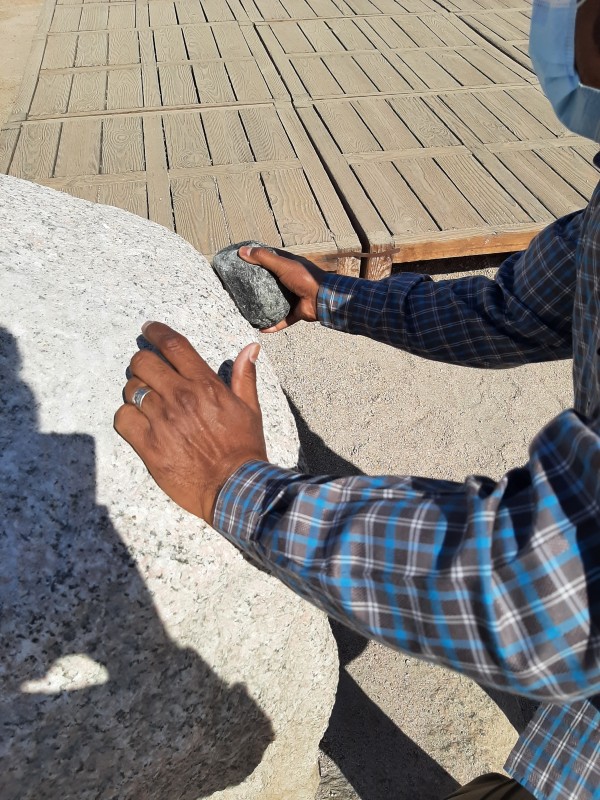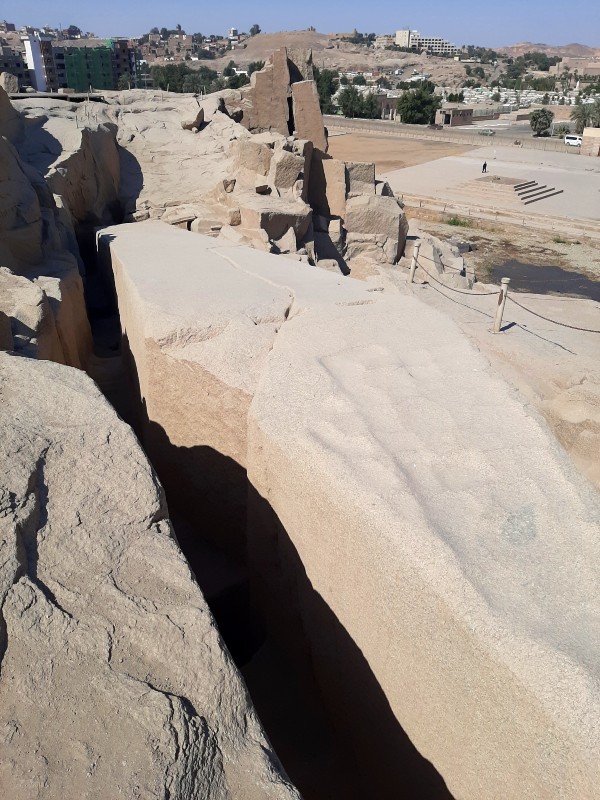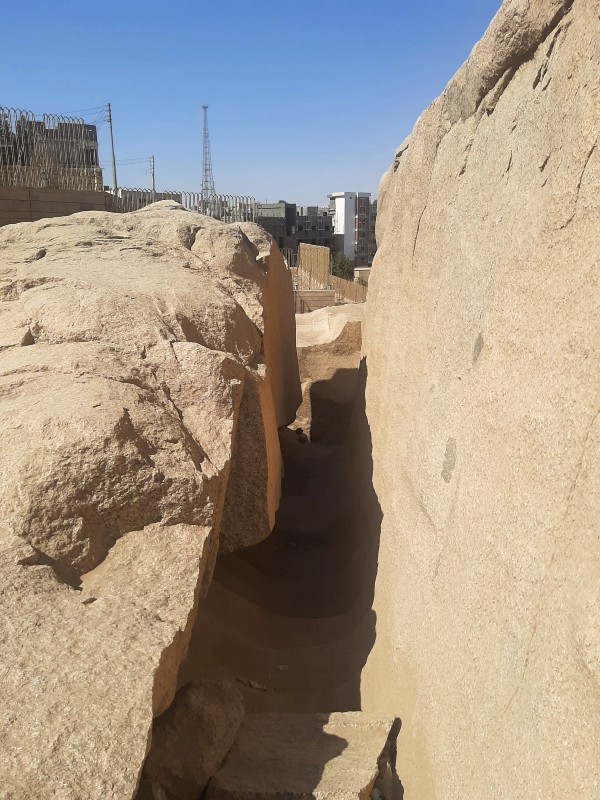The Ancient Quarry of Aswan and the Unfinished Obelisk
In this destination trip report we visit the unfinished obelisk of Aswan in one of the ancient Egyptian quarries.
Aswan
After a fun train ride on the Ernst Watania night train I found myself in Aswan, Egypt’s most southern city. In Aswan I would start my cruise on the River Nile, taking me downstream towards Luxor.
I had arranged the entire cruise package through Luxor & Aswan Travel Agency, a tour agency which I can wholeheartedly recommend as I had nothing but good experiences.
Included in my cruise package were visits to almost all the sights along the route with a private guide, whom I would meet at the station in Aswan.
Indeed, my delightful guide Mohammed Badawy was waiting for me in front of the station building and warmly welcomed me to his hometown of Aswan.
Mohammed explained that first we would visit two major ancient Egyptian archaeological sites in Aswan and that around lunchtime we would check in at the riverboat. To visit the sights in and around Aswan we would have our private car, a comfortable SUV which was well-stocked with cold bottles of water.


Stone quarry
Our first stop for today was the ancient Egyptian quarry of Aswan where stonemasons carved all kinds of obelisks and statues from granite.
In ancient times, there were many different quarries in and around Aswan for a simple reason.
The rocks were of good quality and it was easy to transport the finished obelisks and statues downriver by boat as all quarries were just a short distance away from the banks of the Nile.
Although the quarry is one of the lesser-known ancient sites in Egypt, it turned out to be a fascinating visit.
That was certainly in big part due to the expertise of my guide Mohammed, who had studied archaeology at university and is a great source of knowledge about ancient Egypt.
In an interactive and imaginative way, Mohammed explained how the ancient Egyptians were able to create giant, perfectly shaped obelisks well over 3,000 years ago.


The unfinished obelisk
Without a doubt the highlight of the Aswan quarry is the unfinished obelisk.
This large obelisk has only been partially carved out of the rock as the project was abandoned when the stonemasons discovered a huge crack down the middle which couldn’t be fixed.
Thanks the unfinished obelisk, archaeologists have learned a great deal about stone carving techniques in ancient Egypt.
The unfinished obelisk is certainly an impressive sight. Although it may not be as evocative and internationally known as the Pyramids at Giza or the temples and tombs at Luxor, it certainly is as interesting if you want to learn more about Egyptian history.
To do justice to the quarry and the unfinished obelisk it is however highly advisable to have a quality guide with you, and I was certainly happy that I had Mohammed with me to show me around.
I doubt a visit to the quarry would be as interesting without someone who can actually tell you the technical story behind ancient Egyptian stone carving and construction techniques and bring it all to life.

Making an obelisk
As you can see from the unfinished obelisk, these giant objects were carved out of the rock vertically.
The sides of the unfinished obelisk – 42 metres long – have been partially and crudely carved out. The bottom face of the obelisk is however still attached to the bedrock.
To separate the obelisk from the bedrock, the stonemasons used several techniques. Perhaps the most interesting technique involves drilling holes into the rock along a line.
Wooden spikes were then placed into these holes, after which they were wetted with water. The wooden spikes would then expand and crack the rock around the hole, basically creating one rudimentary cut-out along the side of the would-be-obelisk.
After this, the rock could be carved out much more easily with chisels and other tools. The rough surface of the rock was smoothened by rubbing special stones over it.




Craftsmen
As an interesting side note, contrary to popular belief most of the work on large-scale construction projects in ancient Egypt did not involve slave labour.
At a site like the quarry of Aswan, skilled stonemasons and other craftsmen would work year-round and would get paid for the job, benefiting as well from free food and lodging.
Of course, to create the massive temples and pyramids, also a lot of unskilled labour was needed. For this, the ancient Egyptians just used local peasants.
As these peasants were not able to cultivate the lands on the banks along the River Nile during flood season, many would take seasonal work in service of the Pharaoh.
They would get paid with food, beer and even clothing – and would benefit as well from free lodging during the time they spent working away from home.
After the flood season, they would simply return home again to raise the crops on their farms.
Conclusion
Although the unfinished obelisk was perhaps on paper one of the least interesting stops on the itinerary of my river cruise, it turned out to be one of the most insightful.
At the old Egyptian quarry of Aswan, the craftmanship and construction techniques used in ancient times really come alive – although you really need a good guide for this.
I was certainly happy I had Mohammed at my side to explain in detail how the Egyptians were able to create the most fine and exquisite sculptures and objects more than 3,000 years back in time.
The unfinished obelisk is certainly not as pretty to see as the Giza Pyramids or the the tombs and temples of Luxor – but that is not the point.
By visiting the Aswan quarry and the unfinished obelisk, you learn so much about the old construction methods being used that you really start to appreciate all the ancient Egyptian sights you will see afterwards even more.
Trip report index
This article is part of the ‘Walk Like an Egyptian: A Grand Tour of Egypt‘ trip report, which consists of the following chapters:
1. Red-Eye Ramblings of a Late Night Flight to Cairo
2. A Visit to the Pyramids of Giza by Camel
3. Review: Sofitel Nile El Gezirah, Zamalek, Cairo
4. Exploring the Medieval Old Town and Islamic History of Cairo
5. Visiting the Museum of Egyptian Antiquities in Cairo
6. Mar Girgis: The Churches of Christian Old Cairo
7. Review: Ernst Watania Sleeping Train Cairo to Aswan
8. The Ancient Quarry of Aswan and the Unfinished Obelisk (current chapter)
9. A Boat Ride From Aswan to the Temple of Isis at Philae
10. A Visit to the Aswan High Dam and Lake Nasser
11. A Visit to the Nubian Village on Aswan’s Elephantine Island
12. Aswan Guide: A Visit to Egypt’s Most Stunningly Located City
13. A Half Day Trip From Aswan to Amazing Abu Simbel
14. Nile River Cruise Guide: All Info for Your Egypt Boat Trip
15. Review: M/S Princess Sarah Nile River Cruise Ship
16. Nile Cruise: Sailing From Aswan to Kom Ombo
17. A Visit to the Ancient Crocodile Temple of Kom Ombo
18. A Visit to the Temple of Horus at Edfu
19. Nile Cruise: Sailing From Edfu to Luxor
20. Luxor, Egypt: Visiting the Sights of Ancient Thebes
21. A Visit to Luxor’s Giant Temple Complex of Karnak
22. Visitor Guide to Wonderful Luxor Temple
23. Valley of the Kings: A Visit to Luxor’s Ancient Necropolis
24. The Temple of Hatshepsut: A Visit to a Unique Mortuary Temple
25. Review: Sofitel Winter Palace Hotel, Luxor, Egypt
26. Review: Daytime Train Luxor to Cairo, Egypt
27. Review: Steigenberger Hotel El Tahrir, Cairo
28. A Visit to the Pyramid of Djoser and the Saqqara Necropolis
29. A Visit to the Dahshur Pyramid Complex
30. Memphis: Exploring the Old Capital of Ancient Egypt
31. From Cairo to Alexandria by Train: My Travel Experience
32. Review: Paradise Inn Le Metropole Hotel, Alexandria, Egypt
33. Alexandria: A Visit to Egypt’s Historic Mediterranean Port City
34. Egypt: Impressions and Reflections After My Two Week Trip
35. Epilogue: Safety and How to Deal With Street Hassle in Egypt


I just wanted to thank you for your excellent photo journal of Egypt. I was working on my Shutterfly photo book from my own recent trip to Egypt, but found I had forgotten many of the details and descriptions our tour guide had given. Your website was a great help for identifying locations and details I needed. Thank you so much for your help! 🙂 (Yes, I did credit you in my photo book!)
Thanks for the kind words Cari! I hope you’ve come away with some wonderful memories from your trip to Egypt too.